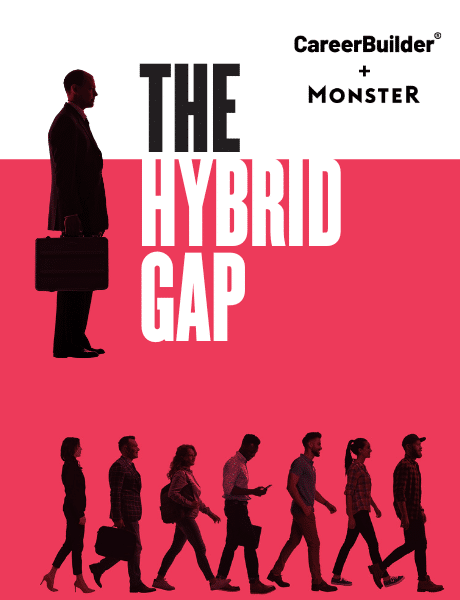Make Sure You Don’t Fall into the Hybrid Work Gap.
You’ve seen the headlines. Felt the tension. Some of the largest global brands tried to mandate a return to the office. Many of their best and brightest talent first resisted, then resigned. Behind the clickbait, we’ve found something concrete: a data-driven shift in what flexibility now means to people across generations, genders and jobs.
The long-term implications for workforce planning are only starting to play out now. The Hybrid Gap explores this shift through expert analysis of our data and research offering insights for leaders designing future-ready work models. Get the clarity you need to bridge the dissonance between business policies and workers’ expectations.
Confusing Presenteeism with Productivity
We’ve seen a steady stream of return-to-office mandates this year, whether that’s demands for full time attendance. Hubble, the flexible workspace platform, even published a list titled “The Official List of Every Company’s Back-to-the-Office Strategy.” As the announcements piled up a common theme emerged – a concern about productivity.
Some leaders have been blunt – suggesting that remote working is little more than sanctioned slacking. Others take a more subtle approach, wrapping their mandates in cultural language. They talk about collaboration, connection, and creativity – but fail to back it up with any meaningful cultural investment.
The Hybrid Gap Reveals a Collision Waiting to Happen
It’s not uncommon for a rising trend to experience a backlash. Remote and Hybrid work happened fast and maybe we weren’t ready for it. It challenged long-standing ideas about what “work” should look like. But the response we’re currently seeing – mandating people back to desks under the guise of productivity – is often rooted in something more regressive: presenteeism.
Visibility vs Value
Demanding visibility only works to exacerbate presenteeism culture, and presenteeism doesn’t lead to productivity. Furthermore, it’s a phenomenon that happens as much online as it does in the office.
Online presenteeism manifests in the form of:
- Back-to-back video calls that leave no time for actual work.
- Instant messages sent after hours, just to be seen.
- Calendar theatre: endless meetings, minimal outcomes.
Performance not Productivity
leaders prioritize visibility over value, they risk creating a culture where looking busy is more important than being effective. Over time, this erodes motivation, trust, and psychological safety.
Poorly communicated mandates don’t just frustrate people – they disengage them. People start to question whether they’re trusted at all. And when trust breaks down, so does productivity. Leaders are more likely to unlock improvements in productivity if they focus on workplace wellbeing rather than hybrid policies.
Whilst wellbeing might be considered a soft metric, work from the London School of Economics, MIT and Oxford University has made a link between workplace wellbeing and productivity (read more about this in our eBook). Those that double down on rigid policies – mistaking control for business effectiveness – are blind to this opportunity.
Why the “Office” Isn’t the Fix
New research from Monster shows that job seekers are actually evenly split on where they think they are most productive. This data reflects not only segment and attitudinal differences but also distinct of roles and responsibilities.
Let’s be honest: bringing people back into a building doesn’t fix broken processes, poor communication, or lack of purpose. It just makes those problems more visible. What gets missed in the push for presence is this: not all work is the same.
Hybrid work may have made it easier to meet, but it hasn’t made meetings better. Many of us spend our days bouncing from one call to the next, with no time for thinking, problem-solving, or deep focus. When we think about what we mean by productivity collaboration is valuable but so is concentration.
Productivity isn’t just personal – it’s contextual. It depends on the type of work, the environment, the team, and the task at hand.
It’s Not One Size Fit’s All
Commercial pressures, uncertainty and a cultural backdrop that is control oriented are likely bleeding into senior leadership decision making. However progressive leaders aren’t getting distracted by this noise. Instead, they are doubling down on more future focused strategies – asking questions instead of issuing mandates.
For anyone looking for fresh data to challenge their thinking our eBook based on Monster’s Future of Work survey is a great place to start.
It shines a light on important topics such as:
- The role of flexible working policy in recruitment and retention
- Understanding how attitudes to flexible working vary across audiences and between leaders and talent
- Attitudes towards hybrid work and productivity by market
- The importance of measuring outcomes not attendance
- Defining different types of work (deep focus vs collaboration)
Return-to-office mandates won’t magically unlock better client satisfaction, innovation, or commercial growth. These outcomes are driven by engagement, alignment, and adaptability – not visibility.
We need to decouple productivity from location, to challenge the idea that you have to be seen to be valuable. Isn’t it better to focus on building cultures that enable people to thrive whether that is virtual, physical, or hybrid?
Apply Insights from the Hybrid Gap to See Real Productivity
The Hybrid Gap: Opposing attitudes to flexible working risk a collision course between talent and leaders, combines real world data from Monster’s Future of Work survey to take an analytical look at the changing work landscape.
Download the eBook today to discover how flexible work arrangements affects both employers and employees. These important insights can help you build a workforce that thrives.
